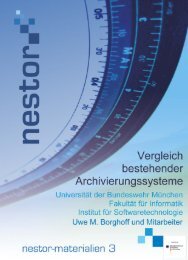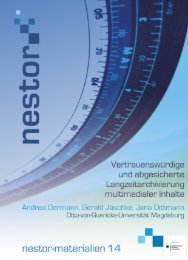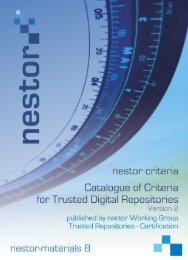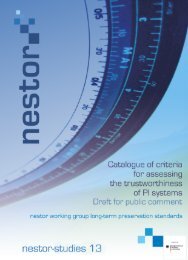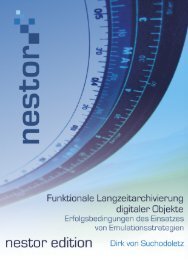Download (PDF, 9MB, Not barrier-free file.) - Nestor
Download (PDF, 9MB, Not barrier-free file.) - Nestor
Download (PDF, 9MB, Not barrier-free file.) - Nestor
- No tags were found...
Create successful ePaper yourself
Turn your PDF publications into a flip-book with our unique Google optimized e-Paper software.
also have to monitor <strong>file</strong> formats, Representation Information (cf. TRAC 2007, B3.2), etc.in order to protect the digital assets it preserves from the danger of obsolescence.Preservation Planning: Develop Preservation Strategies and StandardsTo the extent that the Develop Preservation Strategies and Standards function is also“responsible for developing and recommending strategies and standards to enable thearchive to better anticipate future changes in the Designated Community servicerequirements” (OAIS 2002, 4-14; emphasis added), this function will also have to beaddressed by the three repositories, even if they are not the long-term archive – inparticular as access to the preserved digital objects will always take place through them.As outlined above, regular and well-structured communication between the repository andits digital preservation service provider will be necessary to accomplish this. On the otherhand, strategies spelling out, for example, which steps are to be taken if a <strong>file</strong> format is indanger of becoming obsolescent, have to be developed by the long-term archive. 160As already pointed out above, all three repositories must, moreover, have concepts,standards, and strategies for bitstream preservation and protection, both to ensure thatthese bitstreams remain uncorrupted in the time elapsing between submission to therepository and ingest into the long-term archive and in order to ascertain that usersaccess authentic and uncorrupted publications.Preservation Planning: Develop Packaging Designs and StandardsThe development of packaging designs and standards, too, has to be undertaken bythe repository and long-term archive in cooperation wherever information packages aresubmitted from one to the other. Thus, cooperation agreements will have to be draftedwhich specify exactly the design of the SIPs submitted by the repository to the long-termarchive (e.g. the DNB in the case of pedocs), including required elements and metadata.Thus, for example, it is already clear that pedocs SIPs will most likely include a certain setof descriptive and technical metadata (<strong>file</strong> format and format version) together with thecontent object when submitted to the DNB. 161 In all cases, the design of the SIPs to besubmitted to the long-term archive will strongly depend on the software used to build them(be that the repository software or an external tool such as koLibRI), whereas the designof AIPs to be stored in the long-term archive will be determined by (the requirements andcapacities of ) the latter (including the definition of formats, storage locations, etc. asoutlined in nestor 2008, 10.1). 162 In this context, as required by TRAC, a catalog ofminimum requirements to be met by information packages if their content is to be160 <strong>Not</strong>e that this does not mean that such steps cannot also consist in discussing concrete actions with therepository whose collections have to be migrated.161 The DNB has defined a core set of metadata for electronic monograph publications deposited to the DNB(in German) which can serve as an example for a possible SIP design. See http://www.dnb.de/netzpub/info/pdf/metadaten_kernset_extern.pdf– 25.10.2009.162 One of the most striking differences between the pre-stage AIPs currently stored on the repositories'servers and the AIPs preserved by the long term archive will certainly be the use of preservation metadata,including extensive technical metadata.70



